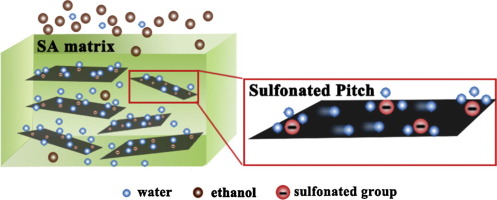当前位置:
X-MOL 学术
›
Chem. Eng. Sci.
›
论文详情
Our official English website, www.x-mol.net, welcomes your
feedback! (Note: you will need to create a separate account there.)
Enhanced dehydration performance of hybrid membranes by incorporating fillers with hydrophilic-hydrophobic regions
Chemical Engineering Science ( IF 4.1 ) Pub Date : 2018-03-01 , DOI: 10.1016/j.ces.2017.12.021 Manru Wang , Hong Wu , Xiaotong Jin , Chen Yang , Xinyi He , Fusheng Pan , Zhongyi Jiang , Chengyang Wang , Mingming Chen , Peng Zhang , Xingzhong Cao
Chemical Engineering Science ( IF 4.1 ) Pub Date : 2018-03-01 , DOI: 10.1016/j.ces.2017.12.021 Manru Wang , Hong Wu , Xiaotong Jin , Chen Yang , Xinyi He , Fusheng Pan , Zhongyi Jiang , Chengyang Wang , Mingming Chen , Peng Zhang , Xingzhong Cao

|
Abstract In this study, sulfonated pitch (SP), composed of hydrophilic sulfonate groups and hydrophobic polycyclic aromatic hydrocarbons, was incorporated into sodium alginate (SA) membranes for ethanol dehydration via pervaporation. The morphologies and structures of the SP and hybrid membranes were confirmed by transmission electron microscopy (TEM), Fourier transform infrared spectra (FT-IR), X-ray diffraction (XRD), field emission scanning electron microscopy (SEM), positron annihilation lifetime spectroscopy (PALS) and water contact angle measurement. Hydrophilic sulfonate groups in SP formed hydrophilic regions which can bind water molecules, ensuring sufficient water occupancy in the membranes, while the hydrophobic polycyclic aromatic hydrocarbons provided continuous transport “highways” for the water molecules. Meanwhile, the introduction of SP created more polymer-filler interface cavities, rendering the membrane with suitable free volume property for separation. Consequently, the membrane demonstrated a maximum permeation flux of 1879 ± 80 g/m2 h coupled with an optimal separation factor of 1913 ± 69 in separating 90 wt% ethanol aqueous solution. These resulted in an increase over the SA control membrane of 1.5-fold and 4-fold respectively. Moreover, the hybrid membranes exhibited good operation stability. The results suggested that incorporating fillers with hydrophilic-hydrophobic regions in the membranes can be an effective strategy to improve the performance of water-permselective membranes.
中文翻译:

通过加入具有亲水-疏水区域的填料来增强混合膜的脱水性能
摘要 在这项研究中,由亲水性磺酸盐基团和疏水性多环芳烃组成的磺化沥青 (SP) 被掺入海藻酸钠 (SA) 膜中,用于通过渗透蒸发进行乙醇脱水。通过透射电子显微镜 (TEM)、傅里叶变换红外光谱 (FT-IR)、X 射线衍射 (XRD)、场发射扫描电子显微镜 (SEM)、正电子湮没寿命证实了 SP 和混合膜的形貌和结构光谱(PALS)和水接触角测量。SP中的亲水性磺酸盐基团形成亲水性区域,可以结合水分子,确保膜中有足够的水占有率,而疏水性多环芳烃为水分子提供了连续传输的“高速公路”。同时,SP 的引入产生了更多的聚合物-填料界面空腔,使膜具有适合分离的自由体积特性。因此,在分离 90 wt% 的乙醇水溶液时,该膜的最大渗透通量为 1879 ± 80 g/m2 h,最佳分离系数为 1913 ± 69。这些导致分别比 SA 对照膜增加 1.5 倍和 4 倍。此外,混合膜表现出良好的运行稳定性。结果表明,在膜中加入具有亲水-疏水区域的填料是提高选择性透水膜性能的有效策略。在分离 90 wt% 乙醇水溶液时,该膜的最大渗透通量为 1879 ± 80 g/m2 h,最佳分离系数为 1913 ± 69。这些导致分别比 SA 对照膜增加 1.5 倍和 4 倍。此外,混合膜表现出良好的运行稳定性。结果表明,在膜中加入具有亲水-疏水区域的填料是提高选择性透水膜性能的有效策略。在分离 90 wt% 乙醇水溶液时,该膜的最大渗透通量为 1879 ± 80 g/m2 h,最佳分离系数为 1913 ± 69。这些导致分别比 SA 对照膜增加 1.5 倍和 4 倍。此外,混合膜表现出良好的运行稳定性。结果表明,在膜中加入具有亲水-疏水区域的填料是提高选择性透水膜性能的有效策略。
更新日期:2018-03-01
中文翻译:

通过加入具有亲水-疏水区域的填料来增强混合膜的脱水性能
摘要 在这项研究中,由亲水性磺酸盐基团和疏水性多环芳烃组成的磺化沥青 (SP) 被掺入海藻酸钠 (SA) 膜中,用于通过渗透蒸发进行乙醇脱水。通过透射电子显微镜 (TEM)、傅里叶变换红外光谱 (FT-IR)、X 射线衍射 (XRD)、场发射扫描电子显微镜 (SEM)、正电子湮没寿命证实了 SP 和混合膜的形貌和结构光谱(PALS)和水接触角测量。SP中的亲水性磺酸盐基团形成亲水性区域,可以结合水分子,确保膜中有足够的水占有率,而疏水性多环芳烃为水分子提供了连续传输的“高速公路”。同时,SP 的引入产生了更多的聚合物-填料界面空腔,使膜具有适合分离的自由体积特性。因此,在分离 90 wt% 的乙醇水溶液时,该膜的最大渗透通量为 1879 ± 80 g/m2 h,最佳分离系数为 1913 ± 69。这些导致分别比 SA 对照膜增加 1.5 倍和 4 倍。此外,混合膜表现出良好的运行稳定性。结果表明,在膜中加入具有亲水-疏水区域的填料是提高选择性透水膜性能的有效策略。在分离 90 wt% 乙醇水溶液时,该膜的最大渗透通量为 1879 ± 80 g/m2 h,最佳分离系数为 1913 ± 69。这些导致分别比 SA 对照膜增加 1.5 倍和 4 倍。此外,混合膜表现出良好的运行稳定性。结果表明,在膜中加入具有亲水-疏水区域的填料是提高选择性透水膜性能的有效策略。在分离 90 wt% 乙醇水溶液时,该膜的最大渗透通量为 1879 ± 80 g/m2 h,最佳分离系数为 1913 ± 69。这些导致分别比 SA 对照膜增加 1.5 倍和 4 倍。此外,混合膜表现出良好的运行稳定性。结果表明,在膜中加入具有亲水-疏水区域的填料是提高选择性透水膜性能的有效策略。











































 京公网安备 11010802027423号
京公网安备 11010802027423号